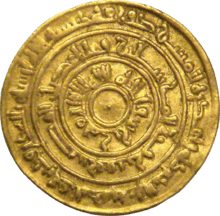Al-Mu'izz li-Din Allah
| al-Mu'izz Li-Dinillah المعز لدين الله | |||||
|---|---|---|---|---|---|
 Gold coin of Caliph al-Mu'izz, Cairo, 969. | |||||
| Caliph of the Fatimid Caliphate | |||||
| Reign | 19 March 953– 21 December 975 | ||||
| Predecessor | al-Mansur Billah | ||||
| Successor | al-Aziz Billah | ||||
| Born | 26 September 931 | ||||
| Died | 21 December 975 (aged 44) | ||||
| Issue | al-Aziz Billah | ||||
| |||||
| Father | al-Mansur Billah | ||||
| Mother | ? | ||||
| Religion | Shia Islam | ||||
Abu Tamim Maad al-Muizz li-Dinillah (26 September 932 – 19 December 975) (Arabic: معد المعز لدين الله "Fortifier of the religion of God"), also spelled as al-Moezz, was the fourth Fatimid Caliph and 14th Ismaili imam, and reigned from 953 to 975. It was during his caliphate that the center of power of the Fatimid dynasty was moved from Ifriqiya (northern Africa) to the newly conquered Egypt. Fatimids founded the city of al-Qāhiratu "the Victorious" (Cairo) in 969 as the new capital of the Fāṭimid caliphate in Egypt.[1]
Political career
After the Fāṭimids, under the third caliph, al-Mansur Billah (946-953), had defeated the Khārijite rebellion of Abu Yazid, they began, under his son al-Mu‘izz, to turn their attentions back to their ambition of establishing their caliphate throughout the Islamic world and overthrowing the Abbasids. Although the Fāṭimids were primarily concerned with Egypt and the Near East, there were nevertheless campaigns fought by General Jawhar as-Siqilli against the Berbers of Morocco and the Umayyads of Spain. At the same time, Fatimid raids on Italy enabled naval superiority in the Western Mediterranean to be affirmed, at the expense of Byzantium, even capturing Sicily for a period of time.
The way to Egypt was then clear for the Fāṭimids, the more so given the state of crisis that the incumbent Ikhshidid dynasty found itself in and the inability of the Abbasids to counterattack. The country fell to Jawhar in 969 without any great resistance. After he had secured his position, al-Muʻizz transferred the royal residence from Al-Mansuriya to the newly founded city of al-Qāhiratu l-Muʻizzīyatu "al-Muʻizz's Victory", i.e. Cairo, thereby shifting the centre of gravity of the Fatimid realm eastwards. In Africa, the Zirids were installed as regents. In Egypt, several attacks by the Carmathians had to be fought off (972-974) before the restructuring of state finances under Yaqub ibn Killis could be embarked upon. Al-Muʻizz was succeeded by his son Al-Aziz (975-996).
Cultural achievements
Al-Muʻizz was renowned for his tolerance of other religions, and was popular among his Jewish and Christian subjects. He is also credited for having commissioned the invention of the first fountain pen. In 953, al-Muizz demanded a pen which would not stain his hands or clothes, and was provided with a pen which held ink in a reservoir. As recorded by Qadi al-Nu'man al-Tamimi (d. 974) in his Kitāb al-Majālis wa 'l-musayarāt, al-Mu’izz commissioned the construction of the pen instructing:[2]
‘We wish to construct a pen which can be used for writing without having recourse to an ink-holder and whose ink will be contained inside it. A person can fill it with ink and write whatever he likes. The writer can put it in his sleeve or anywhere he wishes and it will not stain nor will any drop of ink leak out of it. The ink will flow only when there is an intention to write. We are unaware of anyone previously ever constructing (a pen such as this) and an indication of ‘penetrating wisdom’ to whoever contemplates it and realises its exact significance and purpose’. I exclaimed, ‘Is this possible?’ He replied, ‘It is possible if God so wills’.
Fatimid Literature rose to a certain height of prominence in the period of Al Muizz with the emergence of skilled poets like Ibn Hani al Andalusi and Ali al Tunusi. Ibn Hani was often compared to Al Mutanabbi and hailed as the Mutanabbi of the West.[3]
Relationship with Coptic Christians
Coptic Christians were allowed a degree of freedom under al-Muizz.[4] Copts were among those appointed to the highest offices of the empire and were allowed to freely practice their religion.[5] Under Al-Muizz, the viceroy of Syria was Quzman ibn-Nima, a Copt who remained a Christian.[6] The Nayrouz festival, the celebration of the Coptic New Year, was permitted though prohibitions on some of the activities, such as fire illumination and water splashing, were instituted.[7]
The relationship between al-Muizz and the Copts of Egypt has been the subject of a number of legends written later by Coptic Christians. One such legend involves al-Muizz challenged Pope Abraham of Alexandria to move the Mokattam mountain in Cairo, recalling a verse in the Gospel of Matthew which says:
If ye have faith as a grain of mustard seed, ye shall say unto this mountain, Remove hence to yonder place; and it shall remove; and nothing shall be impossible unto you.
According to Coptic sources, Pope Abraham of Alexandria ordered the Coptic community to keep vigil and to pray for three days and nights. On the third night, Pope Abraham had a dream in which Mary directed him to search for Simon the Tanner. The legend continues that with the prayers of the Coptic community, led by the Pope and Simon, the Mokattam mountain moved. This story is recounted in the book History of the Patriarchs of Alexandria, written by Severus Ibn al-Muqaffaʿ.[6] Later Coptic sources would further assert that this miracle led al-Muizz to convert to Christianity, and that he was baptized at the church of Saint Mercurius in Cairo in a baptismal font that continues to exist to this day, and which known today as the Sultan's Baptistry.[6][8][9][10][11] According to this legend al-Muizz abdicated the throne in favor of his son, and spent the rest of his life in a monastery. This story is rejected by influential Muslim historians such as Ahmad Zaki Pasha and Muhammad Abdullah Enan.[6]
See also
- List of rulers of Egypt
- List of Shi'a Muslims
- Jad Hatem, Le Traité christologique du Calife al-Mu‘izz, le druzisme et le nusayrisme, Paris, Éd. du Cygne, 2013
Notes
- ↑ Irene Beeson (September–October 1969). "Cairo, a Millennial". Saudi Aramco World. pp. 24, 26–30. Retrieved 2007-08-09.
- ↑ Bosworth, C. E. (Autumn 1981). "A Mediaeval Islamic Prototype of the Fountain Pen?". Journal of Semitic Studies. XXVI (i).
- ↑ M. Th. Houtsma, T.W. Arnold. Biographical Encyclopaedia of Islam, Volume 3.
- ↑ West, Gerald O.; Dube Shomanah, Musa W., eds. (2000). The Bible in Africa: transactions, trajectories, and trends. Brill. p. 108. ISBN 978-90-04-10627-7.
- ↑ Gibb, H. A. R. (1979). The Encyclopaedia of Islam. Brill. p. 91.
- 1 2 3 4 A History of Eastern Christianity, by Aziz Suryal Atiya. Taylor & Francis. 1968. pp. 87–88.
- ↑ Phillip, Thomas; Haarmann, Ulrich, eds. (1999). The Mamluks in Egyptian politics and society. Cambridge studies in Islamic civilization. Cambridge University Press. ISBN 978-0-521-59115-7.
- ↑ The Coptic Synaxarium Volume II. Published by Saint Mark Coptic Orthodox Church. Cleveland, OH. 2008. Pages 200-202
- ↑ The Coptic Synexarion Volume I. Published by Maktabet el Mahaba. 3rd edition. Cairo 1978. Pages 173-177
- ↑ كنيسة أبى سيفين ومعمودية السلطان. ما زالت هذه المعمودية الغريبة موجودة والتى تختلف عن أى معمودية أخرى فى الكنائس القبطية , وموجودة حتى الآن فى كنيسة أبى سيفين فى مصر القديمة حيث يردد الكاهن الموجود فى هذه الكنيسة لزوارها عندما يريهم معمودية السلطان أن المعز لدين الله الخليفة الفاطمى قد تعمد فى هذه المعمودية The Sultan's Baptistry at the Church of Saint Mercurius in Cairo. This strange baptistry still exists to this day, and its shape is different from that of all other baptisteries in any Coptic church. It exists to this day at the Church of Saint Mercurius in Old Cairo. The priest of the church tells the visitors that Al-Muizz Lideenilah - the Fatimid Caliph - was baptized at this baptistry.
- ↑ Coptic Synexarion: Pope Abraham
| Al-Mu'izz li-Din Allah Born: 26 September 931 Died: 21 December 975 | ||
| Regnal titles | ||
|---|---|---|
| Preceded by al-Mansur Billah |
Caliph of the Fatimid Caliphate 19 March 953– 21 December 975 |
Succeeded by al-Aziz Billah |
